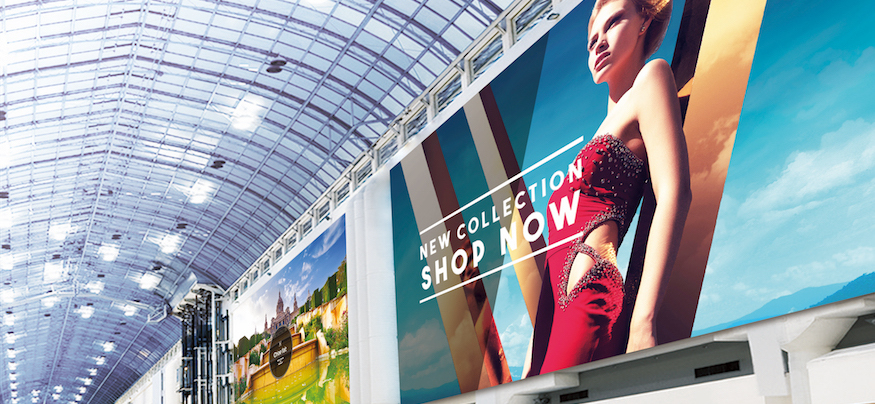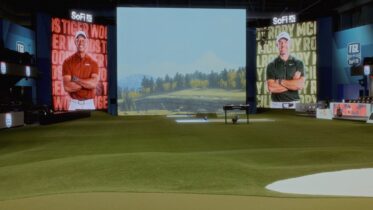Technology advances both in digital displays and supporting infrastructure, along with lowered costs, are making it feasible to implement large, eye-catching video walls — whether it’s for a new corporate lobby, in-store branding or a broadcast set.
The results are evident in high-profile projects in flagship retail stores and big public spaces like airports and rail hubs. But large-scale video walls are also being budgeted and deployed in locations that may not generate as much press attention and media buzz.
Here’s a rundown of the top use cases for video wall signage solutions, involving both narrow bezel LCD display technology and fine pitch direct-view LED:
1. Retail: Apparel retailers, in particular, use large clusters of displays as feature walls in their highest profile stores to reinforce their brand and help set the mood and tone of the store. Other retailers are using video wall arrays in entry areas or other major decision points, like the tops of staircases or escalators. In some cases, notably in consumer electronics, entire walls of stores are clad in display technology — becoming active decor.
2. Corporate: The feature walls in office tower lobbies of major corporations are starting to include LED or LCD walls that celebrate the brand or company achievements, or in some cases, become public art using dynamic or generative data. In the latter, real-time data such as weather or traffic information directly and automatically contributes to organic digital art that steadily shifts as the data changes. Healthcare organizations, meanwhile, use large LCD display walls with touch capability to celebrate and explain the contributions of major donors.
3. Operations: Police departments, security organizations, utility companies and other large entities dealing with a lot of information — and needing to keep steady eyes on it — use large LCD or fine pitch LED display walls in control rooms and operations centers to monitor activity through dynamic charting, real-time numbers and arrays of video windows. The walls become giant dashboards that full teams can see and react to quickly, should the need arise.
4. Advertising: Large-format printed graphics on posters and housed in lightboxes are gradually being supplanted by video wall technology. This shift is happening because display costs have dropped, but also because media companies can add full-motion graphics and video, schedule multiple files instead of just one, and make changes in a matter of minutes — or even on the fly, as audience measurement technologies increasingly take the guesswork out of digital signage content.
5. Broadcast: Ultra-narrow bezel LCDs and fine pitch LEDs are increasingly being used on the sets of local and national broadcasters, replacing static backdrops with digital versions that can change by the show, or even change by the subject during news and talk shows.
Your Ultimate Video Wall Guide
Learn how to build the optimal video wall for your business. Download Now
6. Hospitality: Hotels, restaurants and cinemas are using large-format digital walls in numerous ways around their facilities. Large hotels have developed video walls behind reception desks to greet customers, make them aware of services and amenities, and entertain them during busy check-in times as they wait. Sports and entertainment-themed restaurants are evolving from using single TVs suspended from ceilings to installing giant video walls in great rooms that can show the big game — or be segmented to show multiple games at once.
7. Information: Arrivals and departures displays have been part of mass transportation hubs like airports, train stations and bus terminals for decades, but digital display wall technology is now being used to broaden the kinds of information made available. Airports, in particular, are starting to use wide strips of tiled displays to create changeable images at airline check-in counters and security screening areas. As arrangements change throughout the day, and lines open or shut down, information on the screens also changes.
LCD vs. LED: How To Use Video Walls in Your Space
Installation and management of video walls is now much easier than with earlier versions. The use of LEDs as the backlights that illuminate LCDs has made narrow bezel LCD displays much thinner and lighter, reducing the mounting footprint both in how far they protrude from walls and their weight.
The suppliers who develop mounting systems have also refined and enhanced their solutions to allow for precision alignments — creating tabletop-smooth visual surfaces — and front-servicing, which speeds up maintenance times and, as a result, reduces costs.
While older LCD walls suffered visually from noticeably thick frames (or bezels) which, when joined together, created unsightly gridlines that broke up the visuals, the current generation of LCD video wall displays feature bezels roughly the thickness of a dime. Joined together to create digital walls, the seams between displays all but disappear. With direct-view LED display modules, which join together like wall tiles, the seams are gone completely.
Direct-view LED walls can be as much as five times as costly as LCD walls with the same physical footprint, but they more effectively counteract direct sun and glare, making them much better suited than LCD for locations flooded by natural sunlight.
Narrow-bezel LCD technology can create a large digital canvas at substantially less cost, and pack a lot more pixels into a defined area. A single LCD can deliver a 4K visual, whereas it will take numerous tiled LED modules — with a much larger footprint — to deliver that same visual.
Direct-view LEDs are best viewed from at least 8-10 feet back — any closer and viewers can see the individual diodes, and their tiny lights are fragile and best kept out of public reach. Meanwhile, LCDs safely and easily handle interactive touch and look great from inches away.
The key is to determine what you want and need to do, set a budget, and then strategize implementation.
Learn more about how to plan and build the optimal video wall for your business.








